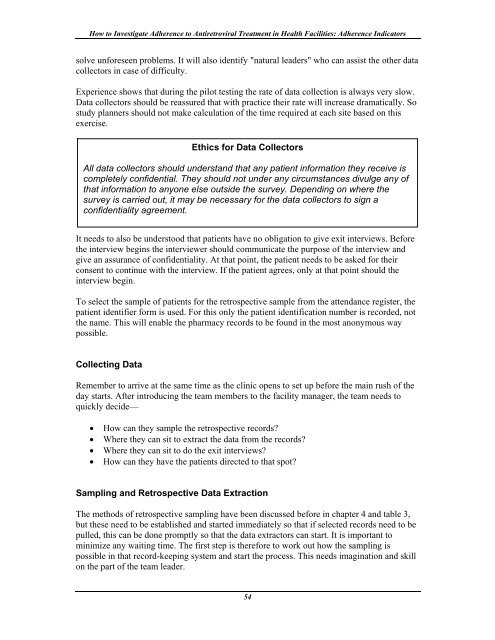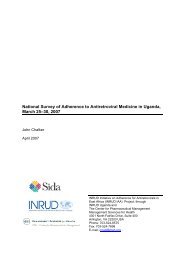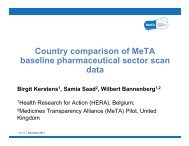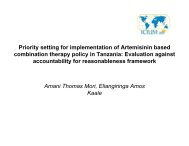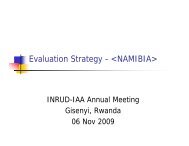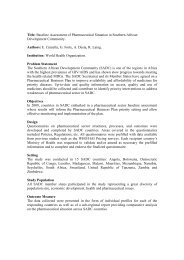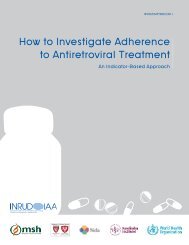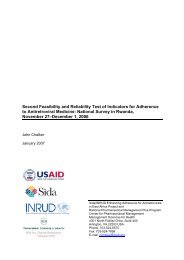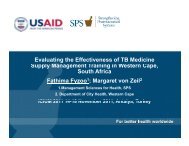How to investigate Adherence to Antiretroviral Treatment ... - INRUD
How to investigate Adherence to Antiretroviral Treatment ... - INRUD
How to investigate Adherence to Antiretroviral Treatment ... - INRUD
You also want an ePaper? Increase the reach of your titles
YUMPU automatically turns print PDFs into web optimized ePapers that Google loves.
<strong>How</strong> <strong>to</strong> Investigate <strong>Adherence</strong> <strong>to</strong> <strong>Antiretroviral</strong> <strong>Treatment</strong> in Health Facilities: <strong>Adherence</strong> Indica<strong>to</strong>rs<br />
solve unforeseen problems. It will also identify "natural leaders" who can assist the other data<br />
collec<strong>to</strong>rs in case of difficulty.<br />
Experience shows that during the pilot testing the rate of data collection is always very slow.<br />
Data collec<strong>to</strong>rs should be reassured that with practice their rate will increase dramatically. So<br />
study planners should not make calculation of the time required at each site based on this<br />
exercise.<br />
Ethics for Data Collec<strong>to</strong>rs<br />
All data collec<strong>to</strong>rs should understand that any patient information they receive is<br />
completely confidential. They should not under any circumstances divulge any of<br />
that information <strong>to</strong> anyone else outside the survey. Depending on where the<br />
survey is carried out, it may be necessary for the data collec<strong>to</strong>rs <strong>to</strong> sign a<br />
confidentiality agreement.<br />
It needs <strong>to</strong> also be unders<strong>to</strong>od that patients have no obligation <strong>to</strong> give exit interviews. Before<br />
the interview begins the interviewer should communicate the purpose of the interview and<br />
give an assurance of confidentiality. At that point, the patient needs <strong>to</strong> be asked for their<br />
consent <strong>to</strong> continue with the interview. If the patient agrees, only at that point should the<br />
interview begin.<br />
To select the sample of patients for the retrospective sample from the attendance register, the<br />
patient identifier form is used. For this only the patient identification number is recorded, not<br />
the name. This will enable the pharmacy records <strong>to</strong> be found in the most anonymous way<br />
possible.<br />
Collecting Data<br />
Remember <strong>to</strong> arrive at the same time as the clinic opens <strong>to</strong> set up before the main rush of the<br />
day starts. After introducing the team members <strong>to</strong> the facility manager, the team needs <strong>to</strong><br />
quickly decide—<br />
• <strong>How</strong> can they sample the retrospective records?<br />
• Where they can sit <strong>to</strong> extract the data from the records?<br />
• Where they can sit <strong>to</strong> do the exit interviews?<br />
• <strong>How</strong> can they have the patients directed <strong>to</strong> that spot?<br />
Sampling and Retrospective Data Extraction<br />
The methods of retrospective sampling have been discussed before in chapter 4 and table 3,<br />
but these need <strong>to</strong> be established and started immediately so that if selected records need <strong>to</strong> be<br />
pulled, this can be done promptly so that the data extrac<strong>to</strong>rs can start. It is important <strong>to</strong><br />
minimize any waiting time. The first step is therefore <strong>to</strong> work out how the sampling is<br />
possible in that record-keeping system and start the process. This needs imagination and skill<br />
on the part of the team leader.<br />
54


